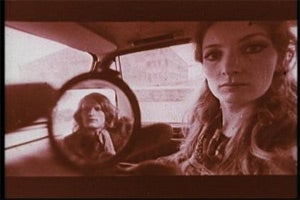Michel Auder Survey, Cubitt Gallery, London
A grainy look at Factory life

Your support helps us to tell the story
From reproductive rights to climate change to Big Tech, The Independent is on the ground when the story is developing. Whether it's investigating the financials of Elon Musk's pro-Trump PAC or producing our latest documentary, 'The A Word', which shines a light on the American women fighting for reproductive rights, we know how important it is to parse out the facts from the messaging.
At such a critical moment in US history, we need reporters on the ground. Your donation allows us to keep sending journalists to speak to both sides of the story.
The Independent is trusted by Americans across the entire political spectrum. And unlike many other quality news outlets, we choose not to lock Americans out of our reporting and analysis with paywalls. We believe quality journalism should be available to everyone, paid for by those who can afford it.
Your support makes all the difference.The second segment of this three-part survey of the art films of Michel Auder, the relatively little-known French-American director, takes us back to the early 1970s, and to Auder's early encounters with Andy Warhol and his entourage.
Auder was besotted by Warhol's practice as a film-maker – by Warhol's use of unadorned, unshaped, unedited reality, caught in real time; by his lifelong obsession with the sheer banality of life, his own and that of others. The three films on display at the Cubitt Gallery until 12 July, which will then be followed by another equally short season of his later films, show us some of the first fruits of that discipleship.
The longest and the best of them is called Chelsea Girls with Andy Warhol (1971-76), and it is a kind of sequel to Warhol's Chelsea Girls of 1966, part documentary and part homage to that film. It consists of a sequence of fairly brief episodes, featuring some of the actors from the original film, and, unsurprisingly, it gives us a great deal of Warhol himself, speaking in that reedy, irritating voice of his down the telephone, or in conversation with the painter Larry Rivers about surprisingly little (when you can hear the soundtrack at all), or in conversation with himself (who better?), musing upon the teeming world of inconsequence as it breezes by.
Auder thoroughly inserted himself into Warhol's circle. He married into it; he even lived in the Chelsea Hotel itself for a spell. And he also happens to have been amongst the first film- makers to begin to use that revolutionary device called a video camera, and to see its potential for cinematic practice; how it gives any individual the power to create films on the hoof; how it gives any individual a voice unlike that of any other, for better or for worse.
The results are grainy, amateurish and often quite enthralling – especially when you listen in to Brigid Polk in telephone conversation with Warhol himself, occasionally hysterical and snarly, always intense, as she sprawls beside an unmade bed in one of those dingy hotel rooms, and spools out her life in dribs and drabs to the man who thought that everything was as important as everything else. So why bother to choose in the first place? The perfect interlocutor, you might say.
The suffocating, eerily narcissistic quality of the Warhol circle is brought home to us so vividly when she says to him, all of a sudden: "I'm always here, being videotaped... I sat here with an unplugged telephone, pretending I was talking to you... " She wants – she thirsts – to have her unhappy, confused life caught on film. It gives her meaning to hear that deadpan, reedy voice talking back at her, and to have her own slightly disheveled, blowsy image – yes, she's not what she was five years before in the original film – thrown back at her. It's proof that she exists. The hand-held camera goes in and out of focus, pitching and tossing weirdly, like a ship in mid-ocean. All that feels about right for the documentation of such mental instability. It's also quite good that we can't hear it all. It probably wouldn't have been worth hearing anyway.
In the third of the films, Auder chronicles another utterly typical Seventies happening: the movements of a heavily sequined and bewigged drag queen troupe called The Cockettes, drifting around New York City, banging drums, dancing wildly, fluttering their eyelashes, getting high on themselves and other stuff; and then, a little later, laughing at themselves caught on TV, as Marc Bolan and John and Yoko sing out subversively in the background, and the only female of the group suckles an inflatable black toy. Ah, such innocent days!
To 12 July (020-7278 8226; http://cubitt artists.org.uk); third part 15-26 July
Join our commenting forum
Join thought-provoking conversations, follow other Independent readers and see their replies
Comments